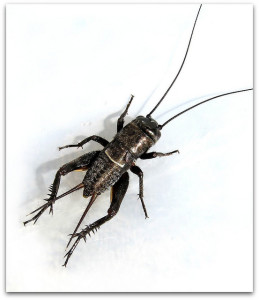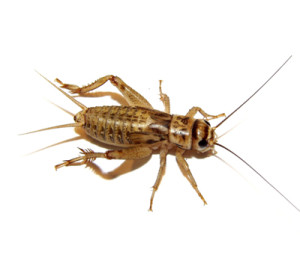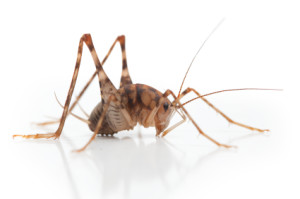3 Common Virginia Crickets
In Virginia the 3 most common crickets are the field cricket, the house cricket and the camel cricket.

Field cricket – They hatch in spring, and the young crickets eat and grow rapidly. They shed their skin eight or more times before they become adults. They eat a broad range of seeds, plants, or insects (dead or alive). They are known to feed on grasshopper eggs, pupae of moths, butterflies and flies. Occasionally they may rob spiders of their prey. Field crickets also eat grass.
 House cricket – The house cricket is typically gray or brownish in color, growing to 16–21 millimetres (0.63–0.83 in) in length. Males and females look similar, but females will have an ovipositor emerging from the rear, around 12 millimetres (0.47 in) long. The ovipositor is brown-black, and is surrounded by two appendages. On females, the cerci are also more prominent.
House cricket – The house cricket is typically gray or brownish in color, growing to 16–21 millimetres (0.63–0.83 in) in length. Males and females look similar, but females will have an ovipositor emerging from the rear, around 12 millimetres (0.47 in) long. The ovipositor is brown-black, and is surrounded by two appendages. On females, the cerci are also more prominent.
House crickets get their common name from the fact that they often enter houses where they can survive indefinitely. Interestingly, they are known for their loud chirping which is caused by rubbing their front wings together to attract females.
 Camel cricket – Camel crickets also known as “sprickets,” spider crickets and cave crickets have an arched back and long hind legs. The ones scientists would expect to find in North America are thick-bodied and a mottled brown in color; they belong to the genus Ceuthophilus. Because they are scavengers, camel crickets may actually provide an important service in our basements or garages, eating the dead stuff that accumulates there. Camel crickets indeed are not picky eaters they will eat anything from American cheese to dead fire ants to human feces to fallen fruit.
Camel cricket – Camel crickets also known as “sprickets,” spider crickets and cave crickets have an arched back and long hind legs. The ones scientists would expect to find in North America are thick-bodied and a mottled brown in color; they belong to the genus Ceuthophilus. Because they are scavengers, camel crickets may actually provide an important service in our basements or garages, eating the dead stuff that accumulates there. Camel crickets indeed are not picky eaters they will eat anything from American cheese to dead fire ants to human feces to fallen fruit.
These crickets may seem like benign little creatures, but they’ll eat through everything from wallpaper glue to wool to silk. And they’ll attract hungry scorpions and spiders. So the best strategy is to keep the chirping pests from getting into your home.
The first step is to locate their nesting place which entails a little detective work. Crickets live in voids, such as under those decorative boulders in your yard, in your sprinkler system’s valve box, or under the sidewalk and patio. Anywhere there’s a space between the ground and another object, you’re sure to find crickets, which love moist, cool hiding places.
When you find a nest and spray it with a pest spray, be prepared to watch what looks like a river of the bugs pour out of it. More than 1,000 crickets can cram into one tiny nest. Once they’re gone, fill in that void with dirt or expansion foam, which you can buy at any home store.
One place you’ll find crickets for sure is around your home’s foundation, especially in that gap between the stem wall and the stucco. Use a product called a home seal—it’s a spray-on foam that helps seal the gaps that allow bugs like crickets to walk right into your home.
Use a mirror to look for large gaps under the bottom of the stucco, especially around the corners, and fill them in. Sealing gaps in the foundation wall itself also will stop scorpions and other pests from coming indoors.
While you’re sealing holes, search for other places where critters can come into the home from outdoors, the roof line and entry points for plumbing and electrical connections, for example. Trim bushes and tree branches so they don’t hang over the roof and drop bugs in places where they can crawl through crevices and into the attic. Even holes in window screens or a gap between a door and the floor are invitations for pests to walk right into your home.
To the best of your ability, create a barrier anywhere where insects could get in out of the sun. If you do that, you’ll naturally bring your pest population down.
If you’re having problems with crickets invading your home Contact PermaTreat for a free inspection and estimate.


































































